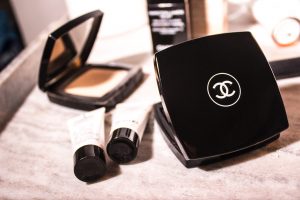Luxe Labels and Logos: Brand Recognition at Its Finest
Published on January 10, 2020, at 5:00 p.m.
by Christina Guyton.
The overlapping LV. The half-Venn diagram double C’s. The stacked YSL. These simple letters represent massive fashion labels with a multitude of operations. From clothing and accessories to makeup and beauty products, how is it that simple, stand-alone letters warrant such a hefty price tag?
The aforementioned logos, representing Louis Vuitton, Chanel and Yves Saint Laurent, respectively, are largely responsible for the sweeping success of these brands. Now more than ever, labels and logos brand individuals, particularly on their social media pages, as people who possess style and money.

The flexing, or flaunting, of brand-name goods has driven the success of many influencers, thus influencing their followers to purchase, or at least pine for, similar goods. Because people want to one-up their followers, fashion and luxury brands are profiting from this show-off mentality. “I want to make sure my belt shows.” “Is my purse in the picture?” These are some of the many statements overheard during the socially acceptable photoshoots held in today’s everyday life. Showing off these pricey goods labels a person on their social media as successful, and their followers recognize these brands, because the logo is doing its job.
Fast fashion brands, like Fashion Nova, PrettyLittleThing and ZARA, are companies that copycat catwalk looks and celebrity culture, quickly producing the cheaper garments so consumers can appear high-fashion, without the exorbitant costs. While these brands can rip off the runway, they’re missing two major markers: quality and that stamp of approval. Places like Manhattan’s Canal Street are infamous for real fakes, where only the quality is missing, and the logo, while comprised of fake metals and miss-sized proportions, is present. Maybe in today’s world, where any Plain Jane or Average Joe can edit a picture to be “Vogue”-cover-worthy, owning faux goods gives the illusion on social that you’ve got it all.
Regardless of fakes and fasts, identifiable fashion brands will never lose dominance because of the value they have built into their logos, and when it comes to brand recognition, letters representing the likeness of an empire are considered a major success. If you represent one of these labels, you can always count on the brand loyalists that gravitate solely to your logo, because it represents something greater: an emphasis on quality and a feeling of luxury.

From a public relations standpoint, this is a great time to represent a fashion line, or any luxury brand for that matter, capitalizing on today’s me culture. Aptly labeled the narcissism epidemic, it is driven by people’s desire to be, or appear to be, dripping in luxury goods, mimicking the affluence-ridden social accounts of the Kardashian-Jenners. While a prolific logo does not exempt your represented brand from dealing with a crisis or backlash, it does position the brand-adorned products as a must-have.
You may never have to pitch a new Gucci product as quality, luxe or worth the price. And with the amount of brand loyalists out there today, who love more than anything to be labeled as a member of Gucci Gang, (let’s also take a moment to thank the rappers who venerate luxury goods, advancing these brands’ influence) you might not even have to prove why your client’s new product is different or even the best.
While a PR professional in the fashion industry has to react to the trends and ever-changing tastes of consumers, established brand logos can be timeless and might even do part of your job for you.




